|
|
Medford Pioneers: John C. Mann 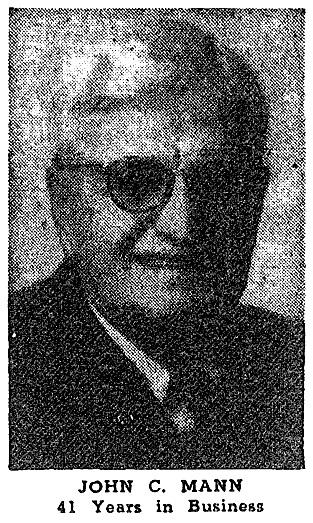 November 29, 1951 Medford Mail Tribune "Here and There," St. Paul Daily Globe, St. Paul, Minnesota, April 9, 1895, page 2 583 Carroll Street, St. Paul, Minnesota: Frederick R. Mann, 64, born Sept. 1835 in Canada, parents in England, wallpaper Mary Mann, 62, born Mar. 1838 in Canada, mother born England, father Massachusetts Frederick Mann, 37, born 1863 in Canada, salesman John Mann, 35, born Mar. 1865 in Canada, salesman Helma Mann, 32, born Feb. 1868 in Canada, teacher Charlotta Mann, 28, born Feb. 1872 in Canada Mina Mann, 25, born Mar. 1875 in Canada Josephine M. Mann, 24, born 1875 in Canada, teacher Edith Mann, 22, born Jan. 1878 in Canada, at school Douglas Moffatt, 20, born June 1879 in Canada, at school U.S. Census, enumerated June 9, 1900 The Mealey Dry Goods Company, of this city, incorporated yesterday with capital stock of $25,000. The incorporators are John Mann, who is president; Louis Schimmel, vice president, and George Mealey, secretary and treasurer. "City News," St. Paul Globe, August 17, 1901, page 2 MANN, John C., president Mealey Dry Goods Co.; born in Canada, 1865; son of F. R. and Mary (Woodsworth) Mann; educated in public and high schools of Goodrich, Ont. Began active career in dry goods business at Goodrich, 1879; came to St. Paul 1883 and became connected with Michael Mealey, dry goods and notions; on the retirement of Mr. Mealey in 1902, the business was incorporated as the Mealey Dry Goods Co., of which he is president. Club: Commercial. Office: 7th and Wabasha sts. Residence: 583 Carroll St., St. Paul. Albert Nelson Marquis, The Book of Minnesotans, Chicago 1907, page 339 583 Carroll Street, St. Paul, Minnesota: Frederick R. Mann, 74, born in Canada, parents in England, self-employed, decorator Mary Mann, 70, born in Canada, parents in England Frederick Mann, 46, born in Canada, manager, decorating company John C. Mann, 44, born in Canada, manager, decorating store Helena Mann, 40, born in Canada, teacher, public schools Matilda C. Mann, 38, born in Canada Nina Mann, 36, born in Canada Josephine M. Mann, 34, born in Canada, librarian, public schools Frederick Moffatt, 21, grandson, born in Minnesota U.S. Census, enumerated April 23, 1910 J.
C. Mann, for 25 years a business man of St. Paul, Minn., has purchased
the store that C. F. Hurlburt was preparing to open in the
Baker-Hutchason old stand.
The new store will be conducted along modern lines. Up-to-date lines of dry goods, notions and ready-to-wear garments will be carried, and sold at popular prices. Mr. Mann heard of Medford while on a recent tour of the West, stopped to see the town and decided to stay. He is a hustler, as shown by his determination to hold an opening Friday afternoon. C. F. Hurlburt, who has been in poor health, regrets having to leave Medford and recommends the new "Mann" very highly. L. F. Ferguson, the able manager for Mr. Hurlburt in his recent sale, will remain with the new store. This will no doubt be welcome news to Medford people. Medford Mail Tribune, September 26, 1910, page 5
JOHN C. MANN WEDS MISS MARGARET BOOTH
Word
has been received of the marriage of John C. Mann of this city to Miss
Margaret Booth at Los Angeles on New Year's Day. They will make their
home in this city.Mr. Mann is one of Medford's leading merchants. Mrs. Mann resided several months in the city, removing to Los Angeles. Excerpt, Medford Mail Tribune, January 3, 1913, page 2 J. C. Mann.
The year 1913 did not start out very promising, but it has far exceeded
our expectations and has turned out to be the most prosperous one for
us that we have had. We start the new year full of confidence in the
future of Medford, believing that it is the best place to live, the
best place to do business, and has the best people in America. There is
no reason why 1914 should not be the best year for everyone. Let us do
our best to make it so."How Medford Merchants and Leading Firms View 1914 Prospects from Prosperity Angle; Optimistic," Medford Sun, January 1, 1914, page 6 Mother of Bismarck Editor Dies in St. Paul--Son Present.
(Herald Special Service.) Bismarck, N.D., Dec. 30.--Mrs. Frederick R. Mann, mother of George Mann, editor of the Bismarck Tribune, passed away at her home in St. Paul yesterday. Editor Mann was at her bedside when she died.
Daily Herald, Grand Forks, North Dakota, December 31, 1915, page 1 A Progressive Minnesota Concern
The term "Twin Cities" has been quite
popularly applied to these two large Minnesota towns, St. Paul and
Minneapolis, but if eastern or southern decorators and painters ever
visit here they will, perhaps, say these Minnesotaites ought to be a
little more careful how they use the word "twin"; for they will
probably fail to discover any real semblance between the two places. As
a matter of fact, they are quite unlike, for the streets differ in
appearance, the public buildings bear no similarity and Minneapolis
leads in point of population by nearly a hundred thousand.An Interview With a Leading Firm of Decorators in St. Paul. By Geo. Wilfred Wright. 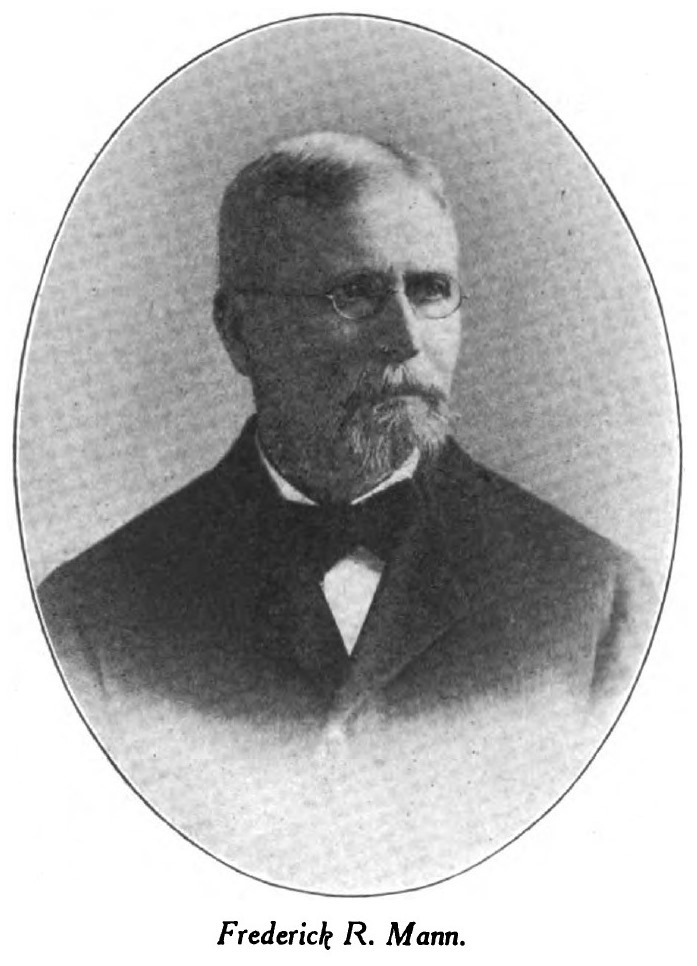 Thirty-Five Years in the Painting Business.
In the painting and decorating business
of this fine city, I found a concern which has been established over
thirty-five years and has enjoyed a wide share of the local business in
their line—F. R. Mann & Son, Incorporated. This firm handles
both a domestic and an imported line of wall papers and they are also
engaged in high-grade painting and decorating work. In referring to the
growth and development of the business, Frederick Mann, the president
of the concern, said: "Our work in this city has been steady and fairly
constant. We have always maintained a high standard, so far as the
quality of our work is concerned. Of course, settling here in St. Paul
thirty-five years ago, and opening a shop when the town was a third the
size it is now, has given us the advantage of growing with the city and
becoming well known, through our early customers, who were prominent in
the development and civic life of the entire community. We have been
here, on [437-439] St. Peter Street, more than thirty years and. in
this sense, the F. R. Mann & Son store is almost a landmark."Business Secured by Merit.
All painters are interested in
learning the best ways to procure business. Various kinds of methods
are used to attract attention and get a hearing from the public. Once
in a while I'll find a very "live wire" business man, who has taken
hold of advertising like one who attempts to take the proverbial bull
by the horns, and he has accomplished wonderful results—Ballou,
of Worcester, Mass., is a shining example. But the Mann Company present
a case which is quite the opposite to those who are convinced that the
free use of printer's ink and paper will help them in their efforts to
win trade and make money. So on advertising Mr. Mann had this to say:
"We never solicit business; but we have found that it comes to us
through doing only good work—giving careful service and charging
fair prices. These points help in the recommendation of pleased patrons
to friends or acquaintances."Advertising men may hoot this idea of building a business without constant publicity, but it should not be overlooked that, unless service is given nowadays, all the advertising in creation is not going to keep the customers nor will it bring in new ones. Managers have awakened to this idea of service as never before, and as advertising is being coupled up with real, intelligent help for the customer, the store owners and merchants are beginning to feel the effects in a highly satisfactory manner, although a business house may not advertise and win trade through these modern methods, but rely on giving service and receiving the patronage of a satisfied public, yet it is well worth observing that when good, strong, forceful publicity is made a part of the business there will be a big increase in profits. 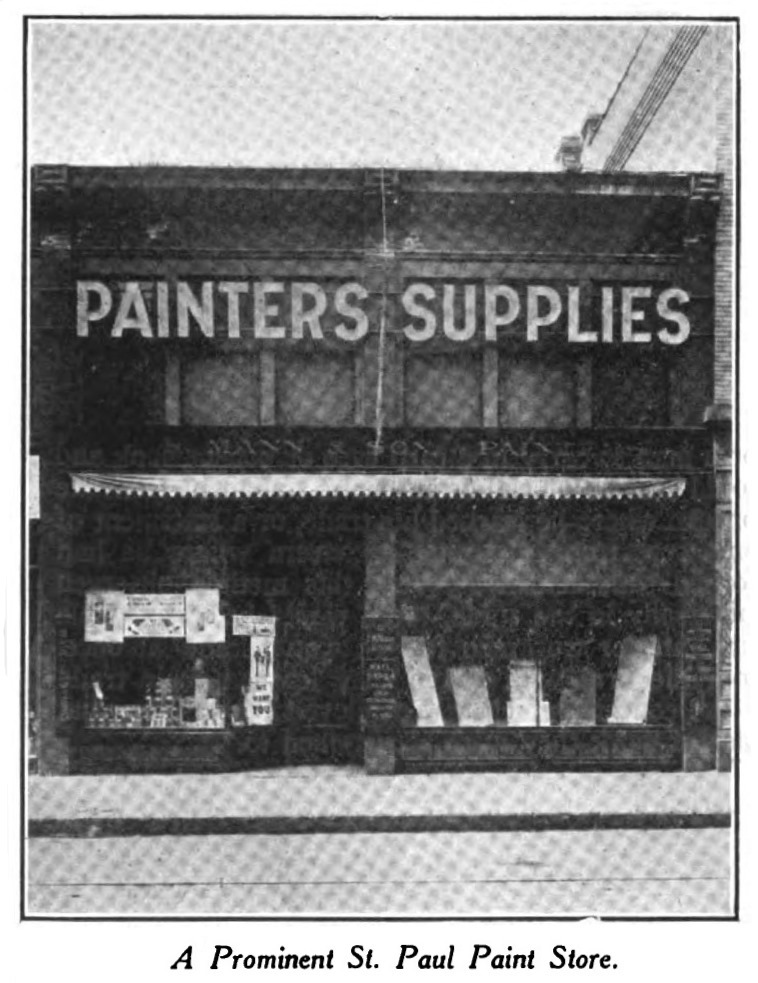 Labor Conditions in St. Paul.
Speaking of labor conditions in St.
Paul, Mr. Mann remarked: "Painters here have to continually guard
against the poor, inferior workman that sometimes comes floating around
looking for a job. It has occurred to me that one way to help matters
in our trade, in this respect, is to have what I term an 'Efficiency
Card.' This would be a card of convenient size for a man to carry in a
card case or pocketbook and would bear an official or authentic
statement from the concern where he learned his trade, or a statement
of some sort from a reputable concern where he had worked
satisfactorily. Were this method observed universally in the trade,
there would be less trouble with inferior workmen for we would know at
once, from the firm with whom they learned their trade or the concern
which last employed them, just what class of work they were accustomed
to."This idea, advanced by a decorator of Mr. Mann's experience, is well worth considering. There is no system of this kind in use, so far as the writer knows, in a general way which could be recognized by painters, decorators and like craftsmen anywhere in the United States; so a record of a man's ability would be ideal in this respect when he made application for work in any place where he is unknown. As in most other places, so in St. Paul, the unions have their disagreements and ruptures with the contractors and "bosses," but a settlement is usually effected, although often there is a severe loss sustained by all concerned. Mr. Mann believes the labor organizations are wrong in furnishing workmen to stores, when the painting and decorating contractor demand cannot always be met. Apprenticeship.
The subject of apprenticeship came up
in this interview and, owing to the fact that the best interests and
future of the trade depend very considerably on the influx of
high-grade, full-fledged journeymen, I was desirous to know what this
company had to say on that topic: '"During the past three years,"
stated Mr. Mann, "we have had twelve apprentices. That is not a very
large number for a town of this size, I know, but training apprentices
is not as simple and easy as it was years ago. The great trouble is
that they are in such a big hurry to get through with their
apprenticeship and earn a man's wages that many elements of the trade
which they should know are neglected."There's a great deal more to the painting and decorating business than merely applying paint or finishes to walls, woodwork or other surfaces. Color and tint blending and a thorough knowledge of the characteristics of paint and the results that come, if certain methods are not followed out in the preparation of walls and interior or exterior of buildings where paint or finishes are to be applied, are necessary if real success is to be acquired. "Practically all the apprentices we get nowadays leave before they have a complete, well-rounded knowledge of their trade. Largely due to this condition we find such inferior work and a lack of good judgment in no small number of jobs we are called upon to give estimates and arrange to refinish." Carelessness in Painting.
This brought our conversation to a very
interesting point and that was the quality of the material used today
and the careless way paints and finishes are sometimes applied. Mr.
Mann desired that I take a walk with him to one of the large public
buildings of the city, where a wrong combination of wall finish had
been used. This handsome structure was nearly completed, but the
mistake had been made when refinishing the walls, and now dark spots
were showing through, which meant that the work must either be done
over at a heavy loss or the public would be forced to pay for very
inferior or unsatisfactory work."When we have a job of this character," said Mr. Mann, "we lead and oil paint the walls first. This treatment 'grips' the plaster and it cannot strip off. But where plaster is put over terra cotta brick and a gloss oil is used for refinishing, it stops suction; it also takes less oil and for a time may look fairly good and pass inspection, but in a short time there will appear badly discolored spots, exactly as you see them here on these walls. The process I mention of lead and oil paint has proven out, in our work, to be very satisfactory and so far as I can determine is the best way to handle work where wall discolorations are probable." In talking over the subject of procuring good materials, Mr. Mann believes that much depends on the quality of linseed oil that is used today in the mixing of paints. I asked him if there was any positive rule he could give me to test the various qualities of oil. He replied: "We can usually tell by the color. Our long experience in working in oils and paints has given us a fairly good working knowledge of the color or shade a high-grade oil should have. After an oil settles, the true color always shows and we can easily tell its quality. Furthermore, a high grade oil will not have a sediment. This is another way to tell the quality and when a painter uses oil where a sediment remains he will never find his work as satisfactory as when he uses those oils which are free from this condition." Treatment of New Woodwork.
In speaking of the way new woodwork
should be treated, particularly new houses which are exposed to the
weather, Mr. Mann remarked: "Too little attention is paid to the
painting of new buildings the first time. Painters should study the
effects that are produced at various times and profit by what these
lessons teach. Now, we often have new houses to paint and a careful
watch on our work toward getting the best results has taught that about
three thin coats on the exterior new woodwork of a house, or enough to
cover it nicely, is better than to give the building too many heavy
coats."I asked what the prospects were in St. Paul for the painting and decorating trade and how the associations had helped the men who were members. Eastern folks understand that a tense rivalry for commercial importance has always existed between these two Minnesota cities. They are situated close together in a large state and where no other towns of an approaching size are within several hundred miles. Mr. Mann sees a good opportunity for the painter who puts value and service in his work. The public are appreciative of a careful and well executed job and in practically every case the man who strives to give satisfaction has all the work he can handle. St. Paul a Busy City.
There should be considerable
business in St. Paul, as it now contains more than 275,000 people, and
with its big sister only ten miles away is the distributing center of
the vast Central Northwest territory, comprising six states, of which
the smallest is over sixty thousand square miles.St. Paul is the great fur center of this country. A business of more than forty million dollars a year in livestock is transacted here. Besides containing some of the largest wholesale houses in the United States in the following lines, hardware, drugs, groceries, seeds, toys and millinery; it is noted for manufacturing high-class refrigerators, underwear, boots and shoes, hoisting machinery, gasoline fire engines, felt roofing and building paper. What is said to be the largest bakery in the world is located here. St. Paul is one of the few cities that does its own paving and was the first big city in America to adopt the commission form of government. This last statement gives an idea of the advancement and up-to-date ideas that are put forward to give the city every favorable opportunity to progress and become a leader. In St. Paul's manufacturing and industrial enterprises over eighty million dollars are invested; adding the worth of the meat packing business to the values of other products, the amount far exceeds one hundred million dollars. Besides the state capitol, which is one of the handsomest buildings in the United States, St. Paul has one of the finest municipal auditoriums in the world and one of the best historical libraries in this country. Twenty-one banks take care of the financial requirements of the city's business. There are three large insurance companies, fifty-nine literary, scientific and other more or less notable societies, eighty-two charitable institutions, three hundred lodges and secret orders, thirty-nine clubs, two nurseries, an art gallery, eleven hospitals and one hundred and eighty churches. Four daily newspapers keep the town well supplied with current events, while sixty other publications are printed here. St. Paul's Historical Interest.
Minneapolis lays no claim to antiquity.
She says she never points to the hoary past; but the region around St.
Paul was once inhabited by the ancient "Mound Builders." Great mounds
still exist in the city, which signify not only the industry, but the
peculiar habits of this departed race. After the mound builders came
the Indians, and the site of St. Paul was once a famous Indian capital
where the great pow-wows of the Northwest tribes were held, and many a
war whoop resounded to oppose the pale-faced Europeans in their greed
for territory.The French took possession of the land in this section of Minnesota in 1680; it later fell to the English, but in 1783 it became a part of the United States. St. Paul was a village, the chief trading post of the territory, as late as 1848: the rich lands of Minnesota soon attracted immigration and the region quickly became thickly populated. Villages turned to large cities and under characteristic Western thrift and energy these two Northwest cities have become important centers of commerce and industry. 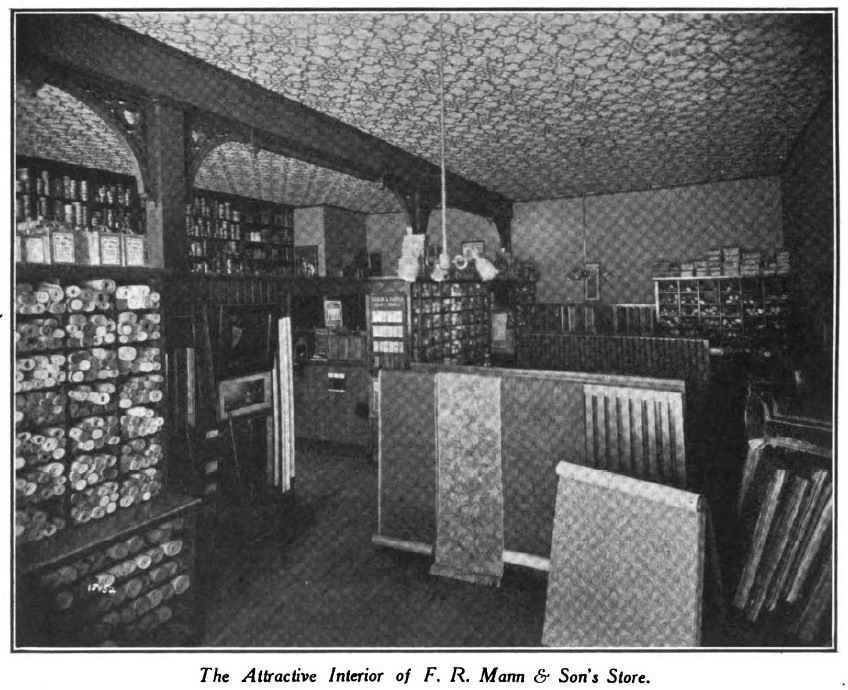 The Wall Paper Business.
Due to the fact that the Mann store
carries on considerable business in wall paper and does a large amount
of the wall papering in St. Paul homes, I asked the opinion of this
company on the outlook of this business. Interior decorators frequently
tell me that painted walls and the various tints that are now
manufactured are proving popular and, to some extent, they have
replaced wall papers formerly so much in use.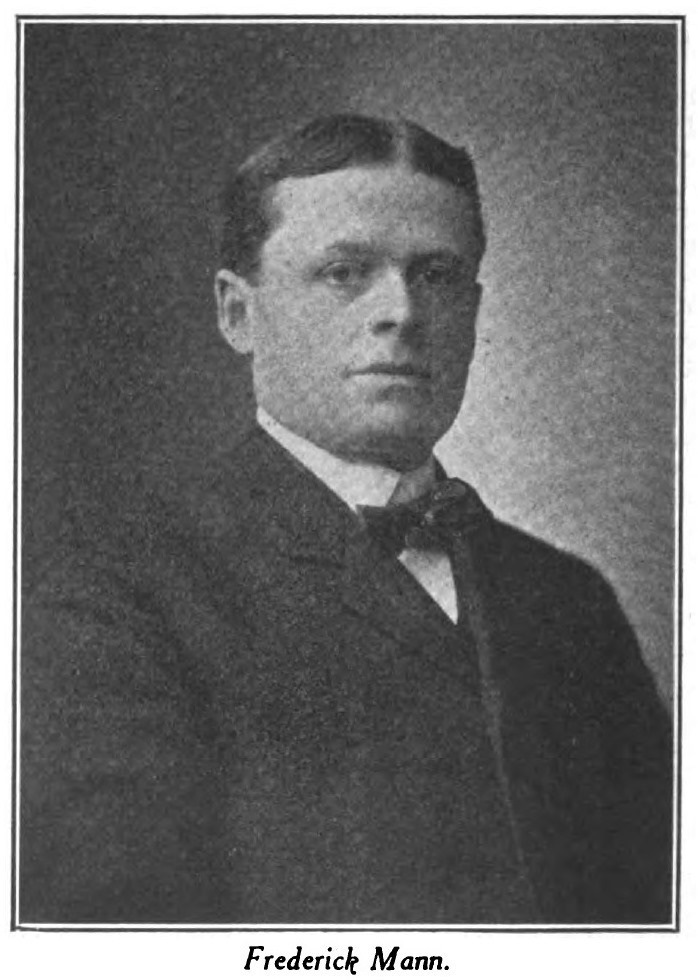 Mr. Mann remarked: "We find here that there is still
a wide demand for wall paper. While the new interior finishes for walls
and ceilings are coming into prominent use, there will always be the
class who will not change their wall paper for anything new. In the
matter of design I think there is an improvement over former
productions. Our American wall paper manufacturers are turning out some
wonderfully artistic work, which will rank with imported specimens and
few can detect the difference. In some cases I have found that the
material was not as good as that used years ago. The stock does not
seem to have the lasting qualities which I would like to see, and on
this point the manufacturers ought to pay very close attention. I
believe there is no reason why we cannot turn out as handsome a line of
wall papers in this country as any concern in Europe can do when
importing conditions with us are normal." Mr. Mann remarked: "We find here that there is still
a wide demand for wall paper. While the new interior finishes for walls
and ceilings are coming into prominent use, there will always be the
class who will not change their wall paper for anything new. In the
matter of design I think there is an improvement over former
productions. Our American wall paper manufacturers are turning out some
wonderfully artistic work, which will rank with imported specimens and
few can detect the difference. In some cases I have found that the
material was not as good as that used years ago. The stock does not
seem to have the lasting qualities which I would like to see, and on
this point the manufacturers ought to pay very close attention. I
believe there is no reason why we cannot turn out as handsome a line of
wall papers in this country as any concern in Europe can do when
importing conditions with us are normal."Mr. Mann's views on this subject of wall papers are interesting and he, with many others, feels he does not have to rely entirely on the foreign product. In a recent issue of The Painters Magazine an example of a strikingly beautiful specimen of wall paper was shown. It was a rich peacock design, originated and manufactured by a Buffalo, New York, house. Considerable favorable comment was passed on the work and it proved more conclusively than ever that American artistic skill is not to be outclassed by the finest importation. The F. R. Mann & Sons' business was originally started by the father and son. A few years later the younger brother was admitted. The company was incorporated in February, 1913. Frederick Mann is president of the concern and Woodsworth Mann is secretary and treasurer. The Painters Magazine and Paint & Wall Paper Dealer, July 1917, page 349 LARGE CROWDS ATTEND OPENING OF MANN'S BIG STORE
A
large crowd is attending the three days' opening at "Mann's greater
Medford store," commemorating his fourth anniversary and store
enlargement, necessitated by increased business. Souvenirs are
provided, while Hazelrigg's orchestra discourses sweet music.
Just four years ago Mr. Mann purchased this store and stock. In these four years, the business has quadrupled, in the face of hard times and general business depression. Every month has seen a steady increase in the volume of business and the number of satisfied customers. His old quarters were outgrown and he has secured the adjoining storeroom and remodeled the establishment, doubling its capacity. How is it that Mr. Mann has been so prosperous, when so many have been complaining? The answer is easy--close attention to business and advertising. Mr. Mann is the largest newspaper advertiser in Medford--and is constantly increasing his space--that is why his store has grown into the "largest, brightest, most complete and busiest" store in Medford. Medford Mail Tribune, October 15, 1914, page 6 FIRST RECTOR OF ST. LUKE'S PASSES AT LONG BEACH
Rev. Daniel Theodore Booth passed
to eternal life at Long Beach, Calif., Sunday morning, July 13. Rev.
Booth was the pioneer rector of St. Luke's Episcopal church at Willmar,
.serving from July 15, 1873 to the fall of 1901. In the early days he
also served a mission district extending west to Dakota, south to the
Minnesota River including Montevideo and Appleton and north to
Paynesville.Deceased was born at Newton, Conn., May 6, 1836. He attended his father's private school, Newton Academy. He came west to La Crosse, Wis., and engaged in business. He entered and graduated from the Seabury Theological Seminary at Faribault, and was assigned to the Willmar field. In 1867 he was married to Miss Mary Esther Nelson at Preston. Their sons, Rev. Laurence Booth and William Booth, are deceased. The following children survive their father: Mrs. W. D. Wiggins of Willmar; Miss Julia Booth of St. Cloud; Miss Mary Booth of New York City; Mrs. S. C. Tompkins of Brawley, Calif.; Miss Gertrude Booth, Long Beach, Calif.; Norman Booth of Willmar; Mrs. John C. Mann of Medford, Oregon; and Mrs. F. H. Bagley of Seattle, Wash. Funeral services were held July 16 at St. Luke's Church at Long Beach. The remains will be taken to Fairview Cemetery at Willmar at a later date. Willmar Tribune, Willmar, Minnesota, July 16, 1919, page 1 John C. Mann, of Medford, has been appointed chairman for the Rogue River group, including Ashland, Grants Pass, Medford and Jacksonville, in the nationwide campaign of the Episcopal Church, organization of which in the diocese of Oregon is now being completed. "Local News," Jacksonville Post, October 18, 1919, page 3 The new electric sign for the Mann department store is being installed over the Main Street entrance. "Local Briefs," Medford Mail Tribune, September 21, 1920, page 2  September 25, 1953 Medford Mail Tribune MANN'S OPENING MARKS EPOCH IN BUSINESS GROWTH
The
fall opening of the "Greater Mann's Department Store" is being held
Thursday, Friday and Saturday of this week, the event signalizing a new
chapter in one of the best-known mercantile establishments of southern
Oregon. The store has been enlarged, now having both a Main Street and
Central Avenue entrance. Among the departments added are men's clothing
and millinery. It is now one of the largest stocked and most beautiful
department stores between Sacramento and Portland, with a rapidly
increasing patronage from northern California, Jackson, Josephine and
Klamath counties. The store improvements have been under way since last
July, and [it] is equipped with a full and complete line of children's
and women's ready to wear garments, men's clothing and furnishings,
dress goods and silks, hosiery, lingerie, millinery, ribbons, gloves
and notions. Specials are being offered this week in the various
departments, while the window displays are attracting favorable comment
from all sides.
Medford Mail Tribune, September 24, 1920, page 8 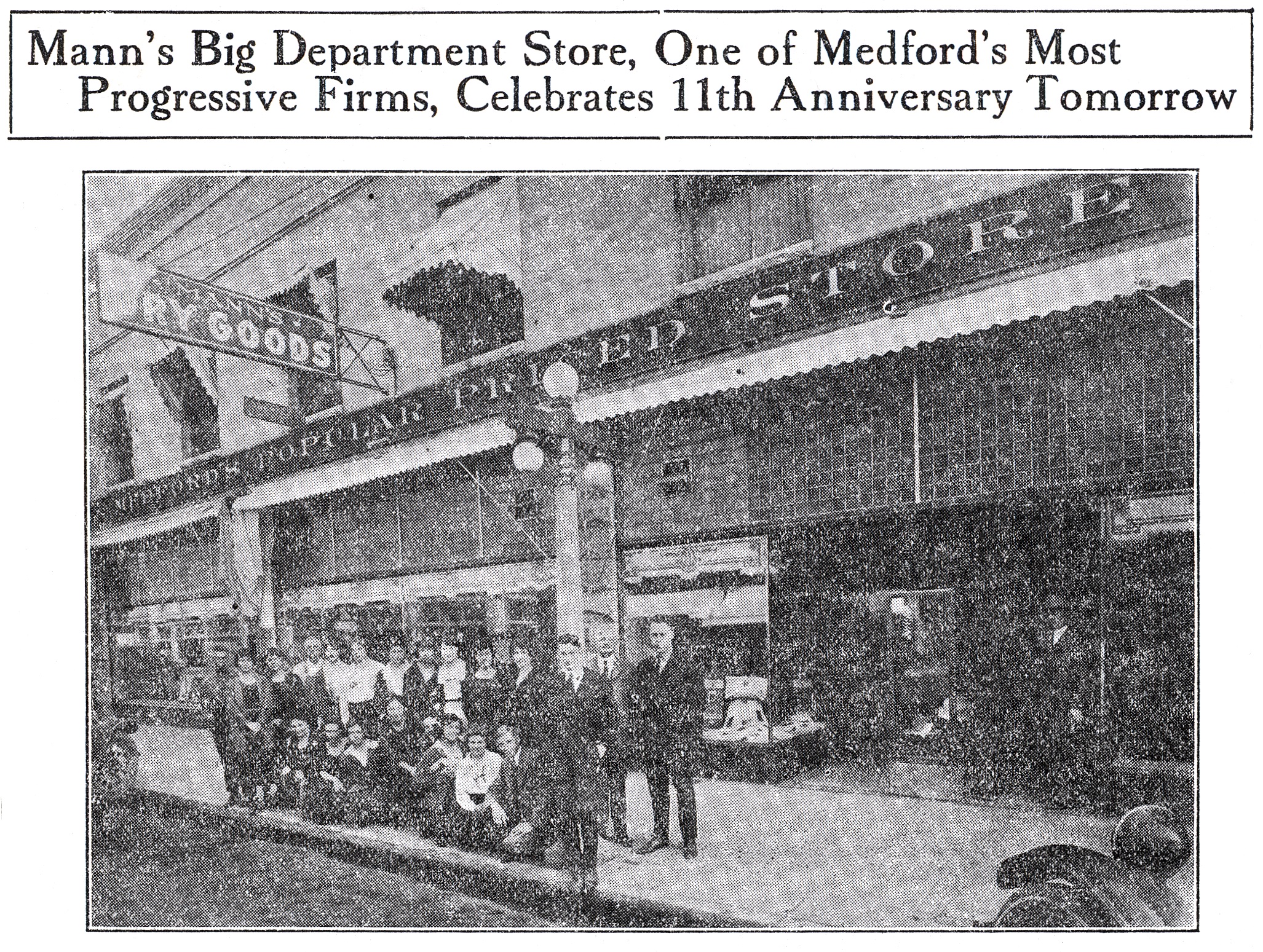 Mann's Big Department Store, One of Medford's Most Progressive Firms, Celebrates 11th Anniversary Tomorrow
The Mann's
Department Store, one of the largest of its kind in southern Oregon, is
celebrating its eleventh birthday tomorrow by launching an anniversary
sale which will continue for the remainder of the month. The growth of
this establishment has been remarkable during the last few years,
having started in 1911 when John C. Mann arrived here from St. Paul,
Minnesota and opened his store with four clerks and a limited stock of
merchandise in a section of the same building he now occupies. Mann's
store now has approximately 8000 square feet of floor space,
twenty-four clerks and a complete men's furnishing department in
connection with its women's section. It handles an enormous volume of
business annually in local and mail order trade and, according to Mr.
Mann, its last year's business showed a marked gain over that of any
previous year.
Mann's store has become a household word among many southern Oregon and northern California people, and the slogan of this store, "the best goods for the price, no matter what the price," is known throughout this section. The success of the Mann's Department Store may be attributed to its well-selected stocks, its sound business principles, the courtesy of its clerks, the excellent service and fair treatment it always affords its patrons and the liberal use of printer's ink. Mr. Mann is one of the largest advertisers in southern Oregon and says he could not think of conducting business without consistent, liberal advertising. John C. Mann, the owner of Mann's store, is an ardent booster for Medford and a strong believer in its future possibilities. He has been active in civic and educational movements as well as prominent in business circles since his arrival here, and the success of his store is an example of his ability and progressiveness. Medford Mail Tribune, September 30, 1921, page 6 MEDFORD MAN ADVOCATES NEWSPAPER ADVERTISING
J. C. Mann, in Talk Before Oregon Retail Merchants Association, Gives Much Credit to Advertising of Bargains MEDFORD,
March 10.--The instructive address of John C. Mann, of the Mann
Department Store of Medford, given at the recent convention of the
Oregon Retail Merchants Association, before the dry goods section of
that body, has attracted much favorable attention. The address, as
reported in the Oregon Merchants Magazine, follows in part:
"When I started to departmentize my store I happened to get hold of a good bookkeeper. I will tell you how we divided up. We made the following classifications: A. Dress goods and silks. B. White goods and domestics. C. Patterns. D. Laces and embroideries. E. Notions. F. Hosiery. G. Corsets. H. Women's ready-to-wear. I. Millinery. J. Men's furnishings. When a department does not pay we analyze the situation and find out what is the trouble. If a department is lagging we put on a special sale and try to bring it up to par. "When we departmentized we were able to watch our purchases closer and found they were getting away from us. We were buying too much and keeping too much. Some months the increase in buying exceeded the increase in sales. When this happens we stop buying. We keep tab each day of sales in each department and keep a monthly sheet showing cash sales in one column, credit sales in another and total in another. We also keep a comparative daily record of each year both as to amounts and numbers of persons sold. We figure we should have more customers each year, so we make a consistent effort to get more people in. "It is very important also to keep account of cash and charge sales returned and charge it up to the individual clerk. At the end of the month we make a comparison of sales of each clerk. We know who deserves a raise and who doesn't." Mr. Mann then went on to give details of the way "we arrive at the different items in our record." Under the item of "turnover" Mr. Mann said: "Departmentizing is a safeguard against stealing. Before I departmentized I had a bookkeeper who stole ten dollars a day from me every day and twenty dollars on Saturday for three years, and I didn't know it." Mr. Mann said he spent 2 percent on advertising and advises keeping advertising expense separate, so you could know what it was spent for--whether direct mail advertising or newspaper space. The most effective advertising medium was informally discussed. Mr. Mann declared the first best advertising medium was the store's windows, then the newspapers, and insisted newspaper advertising must be followed by window displays. Ashland Daily Tidings, March 10, 1925, page 1 Unusual Display Soap at Mann's
In connection with an introductory sale of Royal Cuticle toilet soap,
Mann's department store has put in one of the largest and most
elaborate window displays ever seen in Medford in the form of a
facsimile of the Capitol building at Washington, D.C.
The model is about 10 feet high and 25 feet long. It was constructed by Ralph Burt, Pacific zone manager of the Royal Soap company, and three skilled assistants. Thousands of cakes of soap were used in the construction. It required practically all day today to erect the display, which will be unveiled at 7:30 o'clock tonight. Medford Mail Tribune, June 13, 1927, page 5
RED CROSS PAPER TELLS OF LABORS OF JOHN MANN
A recent issue of the Red Cross Courier, publication
of the national organization, has the following to say regarding John
C. Mann, who has been identified with Red Cross work here for many
years:"After serving as chairman of Jackson County chapter, Medford, Ore., for five years, John C. Mann has resigned the office, although he retains an active interest in chapter affairs as a member of the board of directors. "Under Mr. Mann's chairmanship the chapter has been active in five services. Mr. Mann was instrumental in working out a plan of cooperation between the county court and the chapter on civilian relief, and the latter now handles practically all of the county work. The value of affording opportunity for instruction in swimming and life-saving has long been recognized by Mr. Mann, and a swim week has been a yearly feature of the chapter's program for the last four years. "Jackson County chapter contributed more than three times its quota to the Mississippi flood relief fund, and in the 11th roll call not only exceeded its membership goal, but more than doubled the 10th roll call." Medford Mail Tribune, October 13, 1928, page 3 FORMER HOME PAPER PRINTS AIR GREETING
FROM JOHN C. MANN
An article on the front page of "The Signal," published in Goderich,
Ontario, former home of John C. Mann, carries "Greetings from Medford,
Oregon," in a letter sent by John C. Mann to the hometown paper. The
article is as follows:
"The editor's mail on Saturday last brought a letter enclosed in an envelope which bore the postmarks Medford, Oregon, Oct. 1, and Goderich, Ont., Oct. 5, and a special stamp, 'First Flight, October 2, 1929, Medford, Oregon, Municipal Airport.' The letter bore greetings from the city of Medford and an invitation to attend a celebration in July, 1930, of the formal opening of the new airport with a gigantic aeronautical exposition. This new airport, it is stated, 'Takes the place of Medford's airport which has been in service since 1922 and which was the first municipal airport in the state.' Attached is a note from Mr. John C. Mann, who will be remembered by some readers of The Signal as a member of the Mann family who lived on East Street, in this town, many years ago. Mr. Mann writes: "'Dear Robertson:--If you are still editor of The Signal thought you might be interested in hearing about our new airport, which we open tomorrow. How is the old town, anyway? May pay you a visit ere long. Best regards, John C. Mann.'" Medford Mail Tribune, October 19, 1929, page 2
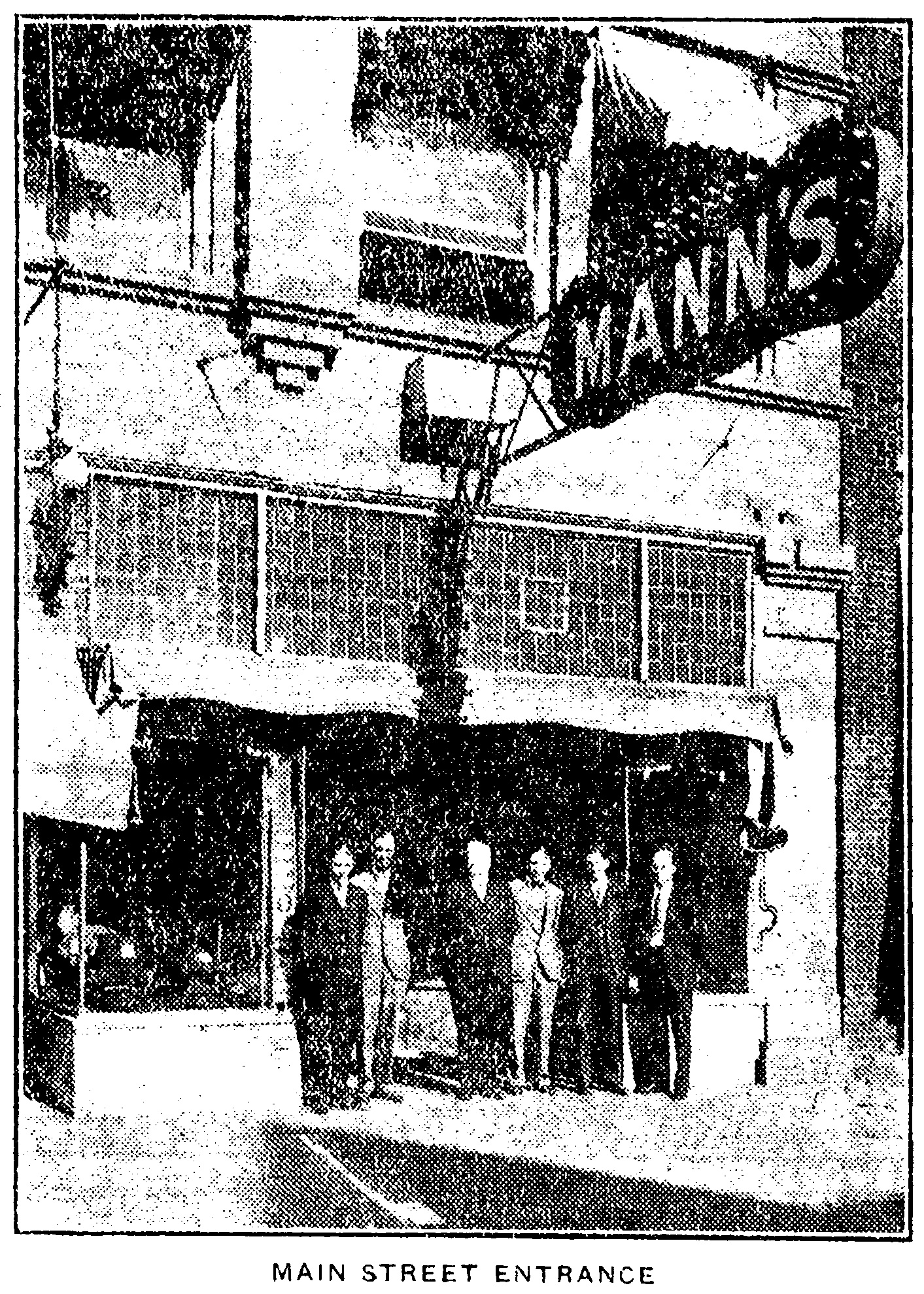 Medford Mail Tribune, October 2, 1927 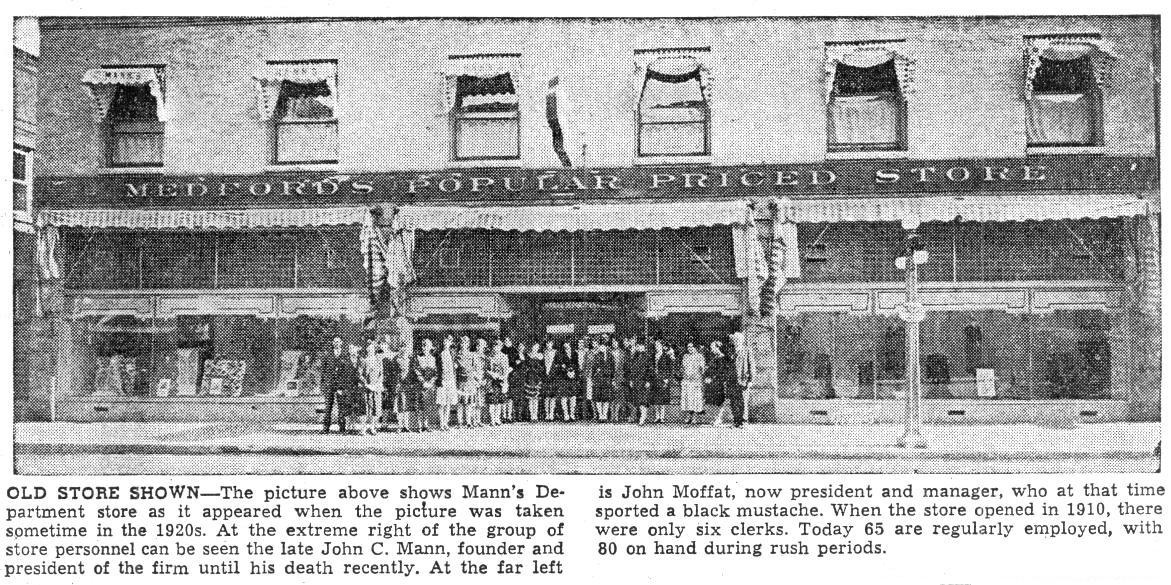 The North Central entrance, 1928. From the Medford Mail Tribune, September 30, 1954. Jno. C. Mann Has 23-Year Record Here Community Pamphlet and Stock of Bankrupt Goods Gave to Medford One of Its Veteran Merchants "Community
advertising pays," says John C. Mann, veteran department store owner
and manager of this city, when interviewed this week by the writer.
"It was through a pamphlet descriptive of Medford and Rogue River Valley which I picked up back in St. Paul in 1910 that I was first attracted to Medford. Later in the year I decided to visit a brother-in-law residing in Los Angeles and hit the train for the West. Although I had disposed of my store in St. Paul and was in search of a location, any idea I had of remaining out here on the coast was so indefinite that I bought a return ticket." Fate Plays Trick
Here Mr.
Mann related that
fate plays strange tricks. "While in Los Angeles I heard that there was
a bankrupt stock for sale in Medford. Completing my visit, I boarded
the train for Medford and found that the bankrupt stock was the residue
of the stock formerly owned by Baker & Hutchinson. Another
party
had purchased it, but acquired what is known as cold feet, and was
anxious to dispose of it."Medford was then enjoying its historic boom. I bought the stock without even taking an inventory, went back to St. Paul, bought additional merchandise and returned." Opened Store 23 Years Ago
"I
advertised my opening for
October 1. That was back in 1910, or nearly 23 years ago. I recall I
was staying at the Nash Hotel and that early on the morning I was to
open my store I arose, looked out the window and saw that it was
raining almost in torrents. I thought that the opening would be
anything but auspicious and estimated that if my volume of sales
amounted to $50.00 that day I would be lucky. Contrary to my
predictions, I found at least 100 people waiting at the doors and
instead of doing $50.00 worth of business the sales for the day
exceeded $500.00."From that day to this, Mann's Department Store has been one of the leading and substantial department stores of Southern Oregon. His ownership and management has been unbroken over a period of almost 23 years. Growth Is Rapid
The
location today is the same as
that in which John Mann opened his store in 1910. Growth, however,
demanded that the original frontage of 50 feet on North Central, with a
single floor, be increased to 75 feet on that avenue, with another
entrance and frontage of 25 feet on East Main, with the present store
occupying two floors and a total floor space of about 17,000 square
feet.Jonas Wold and Martin Reddy occupied the 25-foot frontage adjoining Mann's original store. Wold had a drug store on one side of the room and Reddy a jewelry store on the other side. Five years from the date of opening Mann acquired that frontage. Five years later he acquired the 25-foot frontage on East Main. Continuing enlargement and improvements at five-year intervals, Mann acquired the second floor five years later. Up to that time the second floor had been occupied by lawyers and other professional men. His Platform of Success
Asked to
what he attributed his success in the department store business, Mr.
Mann said:"Consistent newspaper advertising, which is the best form of advertising anyone can buy; selling good and reliable merchandise at a fair profit; standing behind all representations as to merchandise sold; and giving the best of service." Mr. Mann could have added that a complete knowledge of merchandising has been a factor in his success. He began his career as a clerk at 14 years of age, serving three years of apprenticeship in a large department store in his native town of Goderich, Ont., Canada. At the age of 17 he moved to St. Paul, where he continued as a clerk for 25 years, or until 1908, at which time he opened a store in St. Paul. Two years later he disposed of his interests. It was then that the pamphlet telling of Medford fell into his hands and he decided to visit Los Angeles. Although Mann quit high school at the age of 14, he finished the complete grammar and high school course of that age. Active Civic Worker
Although
past the mark of three
score years, John Mann is still a young man. He has found diversion
from his business in an active participation in civic and other
community affairs. He served six years a a member of the
Medford
school board. He was a member of the city council several years, and
served as a director and president of the Chamber of Commerce. In
addition he was president of the Jackson County Red Cross chapter a
number of years, and has participated actively in all affairs connected
with the betterment of conditions in his adopted city and valley.John Mann has no hobby, unless it be his love for football, basketball and other athletic sports. Medford's famed high school football and basketball teams never had a more liberal and enthusiastic supporter than John Mann, and no man has contributed more to putting Medford on the high school football and basketball map of Oregon than he. One Paved Street
Looking
back to that day when he
opened business in Medford Mr. Mann recalls that Main was the only
paved street in the city. Schools and churches were poor, and he says
that one of the outstanding changes with which he is impressed has been
in the improvement of not only schools and churches, but in Medford as
a whole during the 23 years.Of the men in business when John Mann arrived here 23 years ago only a few are "in the harness" today. Among them are C. A. Meeker, "Toggery Bill" Isaacs, Hubbard Bros., Charley Strang, John Butler and "Wig" Ashpole. Has Faith in Future
Like
"Toggery Bill" Isaacs, whose
long and successful career as a businessman was the subject of a story
in this column last week, John Mann is an enthusiastic booster for
Medford and Rogue River Valley, and he is confident of their future. Of
the future of Medford he says:"Medford has a high type of citizenship, and the best prospect for continued and substantial growth of any city in Oregon. Rogue River Valley has a wonderful climate, varied and unlimited resources, and there is no more pleasant spot on earth in which to live." Medford News, June
16, 1933, page 1
EARLY-DAY ARTIST'S WORK DISCOVERED
Stored away in the Weeks & Orr building, tinged with that yellow
which only time can bring, a group of pencil drawings, expressing the
ambition which was Daniel T. Booth's 80 years ago, were found last
weekend.IN WEEKS, ORR BUILDING Who Daniel T. Booth was A. E. Orr was unable to say. The drawings came to the store, he believed, in a collection obtained from the late General Wm. Sooy-Smith of this city. A light border around the edges of one indicates the onetime presence of a frame. Some others are protected with tissue paper flyleaves, which have failed to spare them certain deterioration. A crayon of a river scene in moonlight is scarcely discernible. Pencil drawings of a peasant home scene, waterfowl on the lake, and a portrait of a man in armor, however, might have been drawn yesterday except for the obvious discoloration, verified in the minutely penciled dates at the foot of the drawing, which read 1853, 1854. Most of them are signed by Daniel T. Booth. Medford Mail Tribune, October 31, 1933, page 7 BOOTH'S ETCHINGS ARE RESTORED BY STORY IN TRIBUNE
They were highly treasured by the members of his family, the etchings
done by Daniel T. Booth in his youth. But they wandered away. How,
nobody seems to know. They do know, however, that a story in the Mail Tribune brought them back to their rightful place.Found in the store room of the Weeks & Orr building a short time ago, the yellowed etchings were laid aside unidentified. A. E. Orr did not know who Daniel T. Booth was, but the personal signature attracted his attention. He told the Mail Tribune about it. The story appeared, and Mrs. J. C. Mann, daughter of Mr. Booth, hurried to identify the drawings. She remembered them well. At the age of ten her father began to draw. He kept his etchings, giving each a number and his signature. He wanted to become an artist, but his father strenuously opposed his desire because "artists are always poor." The alternative chosen was little better from that standpoint--Mr. Booth studied for the ministry--Mrs. Mann said yesterday, and became an Episcopal pastor. He kept all his drawings and frequently added to his collection. The etchings found in the local shop were made during his boyhood days in Connecticut. He later came to California and to Oregon. The drawings, Mrs. Mann said, disappeared about 15 years ago. How they came to be in General Sooy-Smith's collection, she did not know, but it was through him, Mr. Orr believed, that the etchings first came to the store. Medford Mail Tribune, November 6, 1933, page 3 MANN'S STORE TO EXPAND, REMODEL IN NEAR FUTURE
An expansion program that will give the Mann's department store here
one of the most up-to-date department stores on the Pacific Coast will
be launched in the near future, a report from John Moffat, store
manager, stated today.
The building formerly occupied by the Hutchison mercantile company has been recently purchased by Scott Davis, who also owns the store building now occupied by Mann's store, and will be remodeled and modernized completely, the ground floor to be occupied by the men's department, and other departments on the second floor. A full-size basement will be dug under the Hutchison section, work to start in the near future, Davis stated today. The front of both the Main Street and Central Street sections will be rebuilt, the Central Street section to have arcades, with a double row of show windows with walk between. The offices, show rooms and floor space will be enlarged and improved., and the partition now between the Mann store on the east and the Hutchison section will be removed. The store now occupied by the men's department will be vacated. The work of remodeling the building is being financed by Davis at a cost of $15,000 to $17,000; the additional cost of the fixtures and equipment will be borne by the store. The entire second floors of both buildings will be air-conditioned. Asked how long the work will take, manager Moffat stated that it would be 60 days or more before the project was completed, but that the store would be open for business during that time. He also stated that the new fixtures, while not radical in design, would be ultra modern and in close harmony with the other improvements. Ten thousand additional feet of floor space will be acquired, and a new arrangement of departments will be made with several new departments added, although plans are not yet completed. Frank C. Clark is the architect of the new building plans. Contracts for the work will be let in the near future, and work will be rushed. Mann's store has been one of the most progressive in the city. Improving constantly in every way possible in past years and the new project is in keeping with the policy of giving to the public the best service obtainable, in the most pleasant of surroundings. Medford Mail Tribune, January 25, 1935, page 6 George Douglas Mann was born June 8, 1879, at Goderich, Ontario, Canada, the son of Frederick Richard and Mary Woodsworth Mann. In 1881 his parents moved to St. Paul, Minn., where his father engaged in the contracting business. With the seven other children in his father's family, George Mann attended the grade and high school at St. Paul and in 1903 graduated from the University of Minnesota, where he distinguished himself as a diligent student despite the fact that he had to work outside of school hours to pay a part of his expenses. "George D. Mann, Tribune Publisher, Dies in Florida," Bismarck Tribune, Bismarck, North Dakota, March 26, 1936, page 1 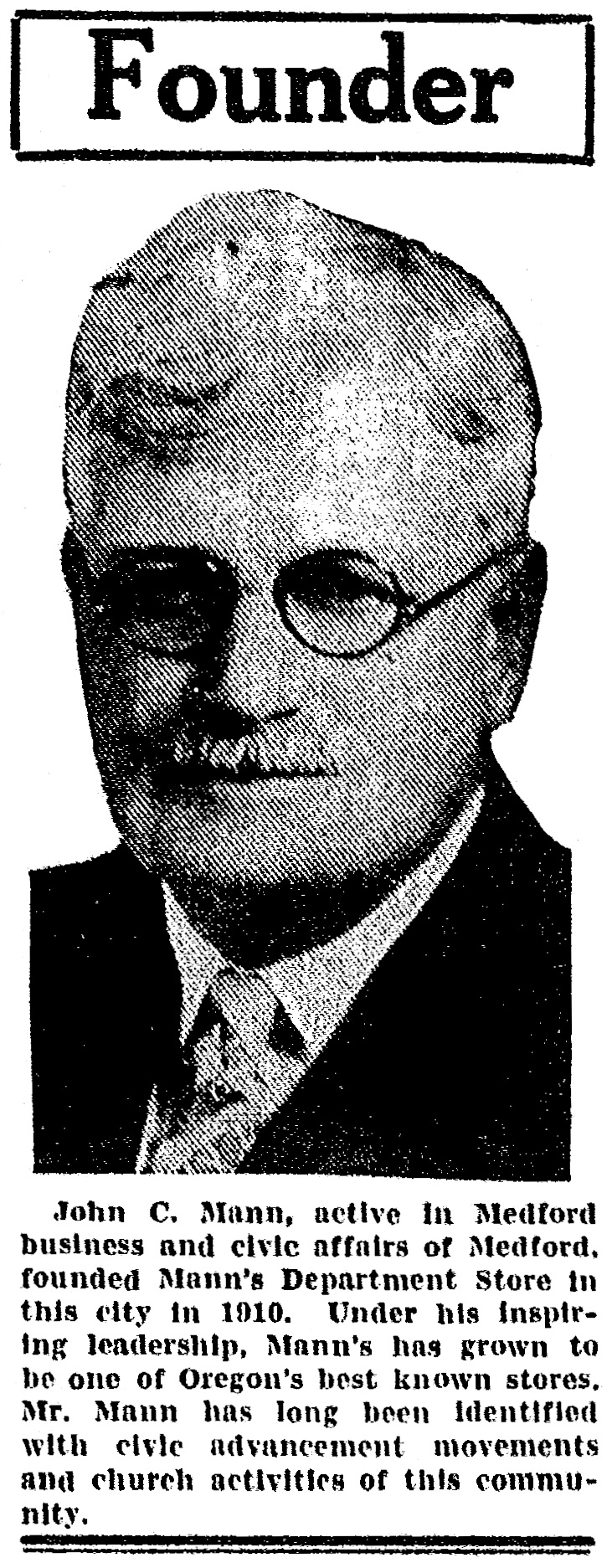 Mann's Department Store Celebrates Its 26th Anniversary
STORE-WIDE SALE BEGINS SATURDAY OBSERVING EVENT John Moffatt General Manager--Hinman Advertising Manager-- Store History and Growth Outlined Mann's
Department Store is celebrating the completion of 26 years of
successful business in Medford with a store-wide selling event opening
tomorrow. This anniversary event also marks the first year of the
operation of Mann's remodeled store, and southern Oregon and northern
California people will be offered outstanding anniversary values as
Mann's expression of appreciation for more than a quarter of a century
of generous patronage.
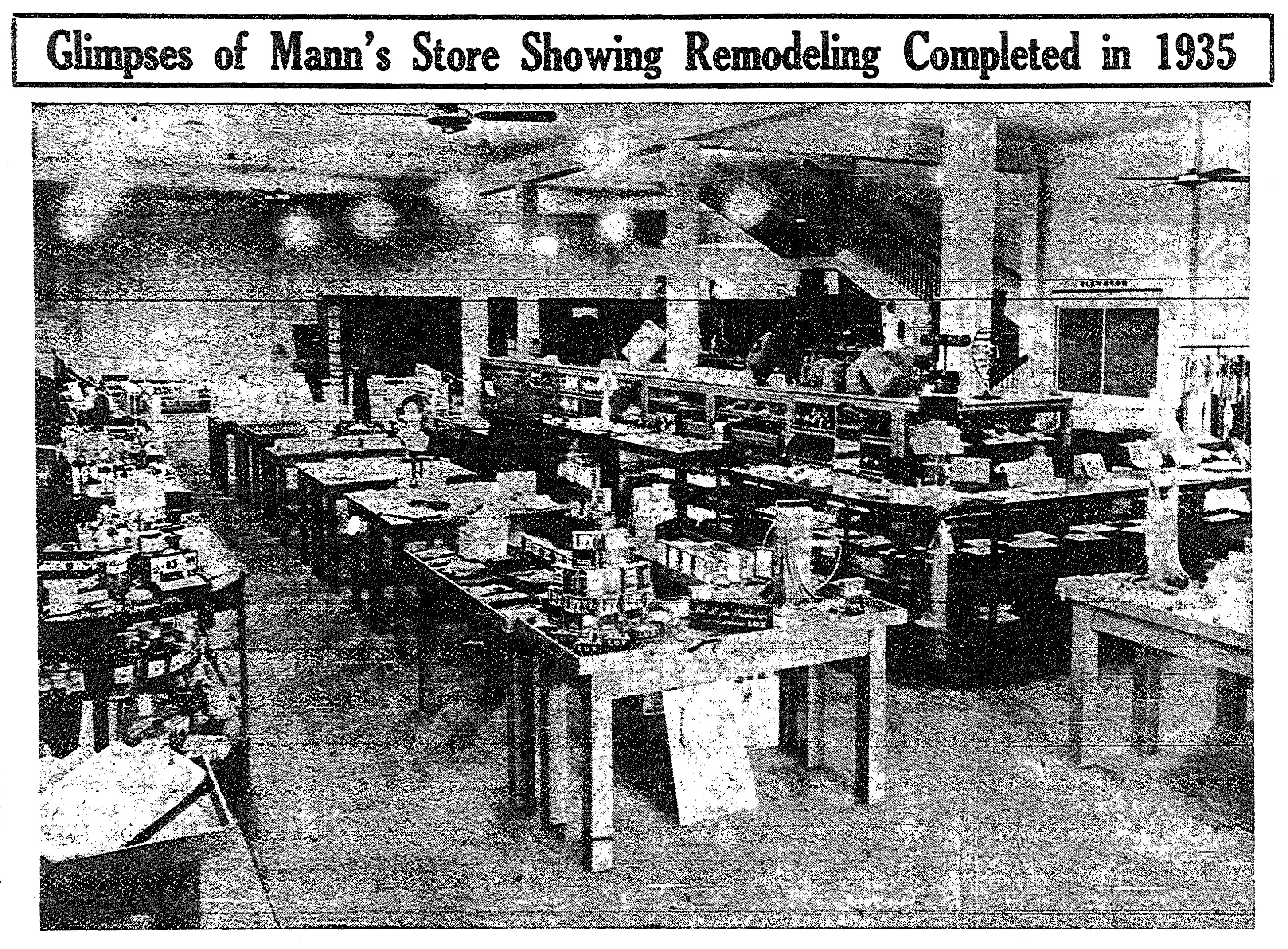 Completely remodeled and air conditioned, Mann's Department Store is one of the state's most attractive shopping centers. Thoroughly departmentalized throughout, every item of apparel for every member of the family is offered to those who shop in this long-established store. For 25 years John Moffatt has been associated with John Mann and is now general manager of the entire store. Under his capable direction, the merchandising program has been decidedly successful. Harry S. Hinman, artist and advertising man, has had charge of advertising and store displays for the past eight years. Mr. Hinman has received much praise for the artistic arrangement of merchandise in Mann's spacious Central Avenue windows and Main Street men's department windows as well as the outstanding advertising copy he has prepared regularly for the advertising columns of the Mail Tribune. Mr. Mann's reminiscences of more than a quarter of a century ago are interesting. He went to work in a general merchandising store at Goodrich, Ontario, 55 years ago for $5 a week. He served a three years' apprenticeship and at that time was 17 years of age. Following that early experience John Mann clerked at Mealey's dry goods store in St. Paul, Minn., and purchased the business at the end of that period. Mr. Mann had heard of the possibilities of the southern Oregon territory, and finally bought a ticket for Medford with a return ticket to his former location in case he might be disappointed. Hutchason's and Baker's store on North Central Avenue was conducting a bankrupt sale. The entire stock was bought by the newcomer, who then proceeded to establish Mann's Department Store, specializing in women's apparel and dry goods. Six clerks were employed in Medford's new store. Business increased steadily, and it was necessary for Mr. Mann to use his return trip ticket to St. Paul in order to secure additional merchandise. Five years after opening Mann's, Mann's expanded with the addition of another store formerly occupied by Wold & Reddy. Again in 1920 the place was enlarged by the addition of a second floor and the men's department was also installed. The final remodeling program was completed at Mann's early in August, 1935, at which time a colorful "open house" was observed and thousands of southern Oregon people inspected the beautiful store. Medford Mail Tribune, October 2, 1936, page B1 MANN, JOHN CLARKSON Owner Mann's Department Store. b. Goderich, Ontario, Canada March 28, 1865; son of Frederick and Mary (Woodsworth) Mann; educated grade and high schools Canada; m. Margaret Booth of Los Angeles and Willmar, Minn. Jan. 1, 1912; daughter Margaret Mary (Mrs. Roger Holmgren), Janet Irene (Mrs. John Crawford); served apprenticeship dry goods store Canada at age of 14, 1879-82; associated with Clarence M. McLain, St. Paul, Minn. 1882-86; with Mealey Dry Goods Co., St. Paul 1886-1906, purchased store, managing owner until 1910; removed to Oregon, owner, Mann's Dept. Store, Medford 1910 to date; vice-president, director, Jackson County Building and Loan Association; member school board six years; member City Council two terms; active many years State Retail Merchants Association; past president Chamber of Commerce; Elk (since 1915); Democrat; Episcopalian (served on vestry and as junior warden); home 815 E. Main; office 14 N. Central, Medford. Capitol's Who's Who for Oregon 1948-49, page 360 MOFFAT, JOHN PAUL Dept. Store Executive; Civic Leader b. Dubuque, Iowa May 12, 1895; son of Robert P. and Elizabeth (Mann) Moffat; educated grade and high schools Dubuque, Iowa; Oregon State College; extension courses; Sigma Nu; m. Mary A. Holmes of Medford, Oregon Feb. 13, 1921; children John P. Jr., William R.; began as clerk, various positions, Mann's Dept. Store, Medford, Oregon 1914, manager since 1938; past president Medford Retail Merchants Association; member school board 1939-; member National Retail Dry Goods Association; member State Advisor Board, Oregon Merchants Association; chairman United War Chest 1941-43; served as director Community Chest and Red Cross; member price panel and O.P.A.; Elk; Rotarian; member Chamber of Commerce (director), Valley Golf Club; University Club; Jackson County Apprenticeship Council; Republican; Episcopalian (vestryman); home 34 North Berkeley Way; office 14-22 N. Central Ave., Medford. Capitol's Who's Who for Oregon 1948-49, page 397 John Mann's Short Visit to Medford in 1910
Turned into 41-Year Stay in City When
John C. Mann, founder of Mann's Department Store, came to Medford 41
years ago, he didn't plan to stay long. He'd been associated with a St.
Paul, Minn. firm for 20 years, and when he came to southern Oregon he
was owner of the store.
In 1910 Medford, to quote Mann, "was in the midst of a boom, and prospects looked rosy." But booms don't always last, and he was prepared to return to St. Paul. "I had a return trip ticket in my pocket and no definite idea of locating in southern Oregon," Mann says. Bought Stock Baker and Hutchason's store was conducting a bankrupt sale at their location on North Central when Mann arrived here. Mann bought up the stock and established a department store. This new store occupied a 50-foot frontage in a part of the present store. It was devoted to women's ready-to-wear and dry goods. Six clerks were employed as the store opened in 1910. As it turned out, Mann's southern Oregon venture was a permanent one, but the return ticket to St. Paul was used after all. His new department store was so well patronized from the start that it was necessary for the owner to make a trip to St. Paul to secure more merchandise. Started at $5 per Month Mann's business career started in Goderich, Ontario, Canada, where he began work in a general store in 1879. Starting at a salary of $5 a month, Mann remained there for three years as an apprentice until he was 17 years old. For 20 years Mann clerked at Mealey's dry goods store in St. Paul and in 1902 he purchased the firm. Eight years later he came to Medford. Medford Mail Tribune, November 29, 1951, page 5 John C. Mann Dies in Sudden Illness Sunday Afternoon Well-Known Merchant Lived Here Since 1910 John
C. Mann, head of Mann's Department Store since he established it here
in October, 1910, died in his sleep at home yesterday afternoon
following a brief illness. He recently observed his 87th birthday.
Mr. Mann was probably the best-known of the older residents of Medford. He arrived here on what he thought was to be a short visit in 1910, when the city was in the midst of its biggest boom. He had no thought of remaining at the time and later said "I had a return trip ticket in my pocket." But, except for brief trips, he spent the rest of his life here and was an active force in the merchandising field of the city, and was also prominent in civic and fraternal affairs. Store Now Largest Under his guidance, Mann's store grew to be the largest in southern Oregon, from the original 50-foot store he purchased the year he arrived. Mr. Mann was born in Goderich, Ontario, Canada, on March 28, 1865. He lived there until he was 17, part of that time clerking in a store at $5 per month. Later he spent 20 years in a store in St. Paul, Minn., before coming to Oregon. His affiliations included the Masons, the Shrine, the Elks Club and the Medford Kiwanis Club, of which he was a charter member and former president. A member of St. Mark's Episcopal Church, he had served on the vestry on several occasions and had also been a warden of the church. He was one of two men to have the honorary title of warden emeritus. Served City Mr. Mann also had served terms on the Medford school board and the city council. He was one of the founders and directors of the Jackson County Federal Savings and Loan Association, and as its president at the time of his death. He was a past president of the Jackson County Chamber of Commerce. Survivors include his wife, Margaret; two daughters, Mrs. Janet Crawford, Medford, and Mrs. Margaret Holmgren, Tulsa, Okla., and five Crawford grandchildren and two Holmgren grandchildren. Mrs. Holmgren was to arrive here this afternoon. Funeral Wednesday Funeral services will be held at St. Mark's Church at 11 a.m. Wednesday, with the Rev. George R. V. Bolster officiating. The family has requested that no flowers be sent and that those wishing to honor Mr. Mann's memory make, instead, a donation to Community Hospital for the establishment of a new bed there. Interment will follow at Siskiyou Memorial Park. It will be a private service. Perl's Funeral Home is in charge of arrangements. Medford Mail Tribune, May 26, 1952, page 1  September 25, 1953 Medford Mail Tribune
Mann's Department Store Sets 43rd Anniversary of Founding
A
store-wide sale which begins Saturday, Sept. 26 at Mann's Department
Store and continues through Oct. 31 will mark the 43rd anniversary of
the founding of the store by the late John C. Mann.
Since opening in 1910 the store stock and space has increased consistently, and during the past year three new departments have been added. They are the television department, which features Emerson, Bendix and Kay-Halbert lines; the sterling silver service by Reed and Barton and an interior decorating department headed by Lewis Pearson. Has Much Experience Pearson has had considerable previous experience in the decorating field both in southern California and in Washington state. The late Mr. Mann arrived in Medford from St. Paul, Minn., and when he purchased the store it occupied about 3,000 square feet of floor space. Today 27,000 square feet of space is utilized. Six clerks were employed at the time he bought the store, and now the number of employees totals 75 persons. John P. Moffat, president and manager, has been associated continuously with Mann's for the past 40 years except for two years' service in the Army during World War I. Have Six Buyers Six buyers now are employed, Lewis Wayburn, Mrs. Mildred Moss, Mrs. Elsie Narregan, Mrs. Alto Pruitt, Mike Dietrich and Jack Crawford. Assistant buyers include Donna Doyle, Leona Bestul, Claire Proctor, Sue Montgomery and Don Piatt. A few other department heads are Dora Carnall, who manages the millinery; and Kenneth Howard, credit and office manager. Mrs. Thelma Howard manages Mann's Beauty Salon, which was established in 1934. A number of the store's employees have been with the firm for many years. They include Mrs. Elsie Narregan, buyer for children's wear, lingerie and hosiery, who has been at the store since 1921; Leona Bestul, assistant buyer in yard goods and linens, who has been with that department since 1939; Margaret Brown, cosmetic department, since 1934; Dollie Miller, with ready-to-wear department since 1942, and Mrs. Alto Pruitt, a buyer for seven departments in the store and with the firm for 24 years. Store Contest In connection with the anniversary sale an annual store contest also will begin Saturday. Each year during the anniversary observance store departments are divided into groups, each group attempting to surpass the other in store sales. A bonus is given the winning team and a dinner for store employees is given. Medford Mail Tribune, September 25, 1953, page 12 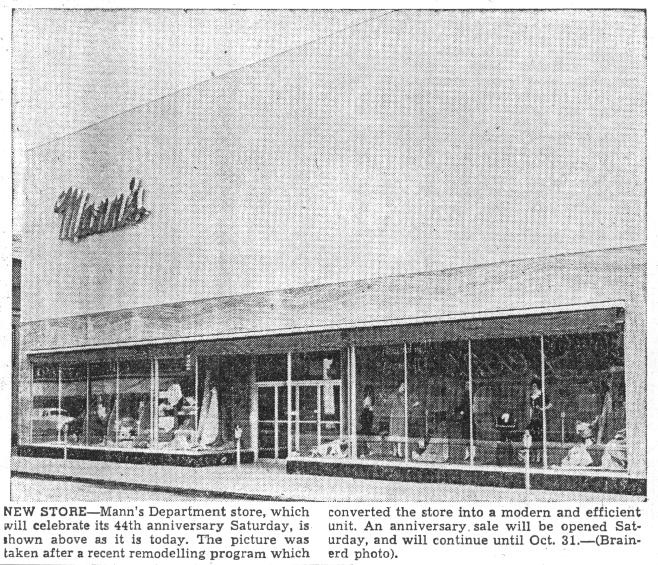 September 30, 1954 Medford Mail Tribune Chain Picks Up Medford Store
MEDFORD (AP)--Mann's Department Store at Medford has been purchased by
the Miller's Division of P. N. Hirsch and Co., St. Louis, Mo.
John P. Moffat, president of Mann's, said that the sale will be effective on Sept. 1. He reported that the store will continue to operate under its present name and policies. The store covers 25,000 square feet of business property at Main St. and Central Ave. Miller's purchased Burelson's ladies' ready to wear store here earlier this year. Medford Mail Tribune, August 30, 1964, page 32 Mann's Store to Close for Remodeling Project in July;
To Reopen as Miller's
Another link in the chain of improvements in the downtown Medford
business district was announced today by Fred Lund, manager of Mann's
Department Store.
The store will be closed Saturday night, July 2, for start of a $250,000 renovation and remodeling program. The store will remain closed until the remodeling and fixture installation are completed, Lund said. It will reopen early in August under the name of "Miller's." There are presently 21 stores in the Miller group operating in California, Washington, Idaho and Oregon. Mann's was added to the group in September, 1964. The store has been in existence as Mann's since 1910, when it was purchased by the late John C. Mann from Baker-Hutchason. Idaho Department Stores, a sister affiliate of Miller Stores, with headquarters in Caldwell, Idaho, operates 25 stores under the names of Keith O'Brien and Idaho Department Store in Idaho, Utah, Colorado, Washington and South Dakota. $250,000 Project
The quarter-of-a-million-dollar
improvement program for which Harold Salter is general contractor will
include a new Main Street entrance, reconstruction of the alley wall
and creation of a new entrance from the alley, providing easy access to
the parking at the rear of the store.There will be new ceilings installed on the main and second floors, new heating and air conditioning throughout with new floor coverings, fixtures, tables, show cases and display racks added, Lund stated. Some departments in the store will be relocated. R. L. Henselman, owner of the building, is participating with Mann's in the improvements. Henselman said today the remodeled store when completed would be among the most modern in Oregon. New heating and refrigerated air conditioning installation, he said, will involve the most modern and effective equipment that can be obtained. Medford Mail Tribune, May 20, 1966, page 1 Last revised May 15, 2025 |
|

